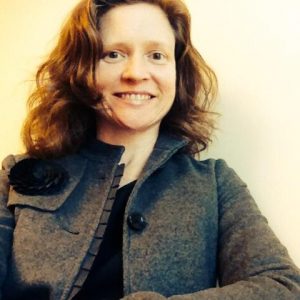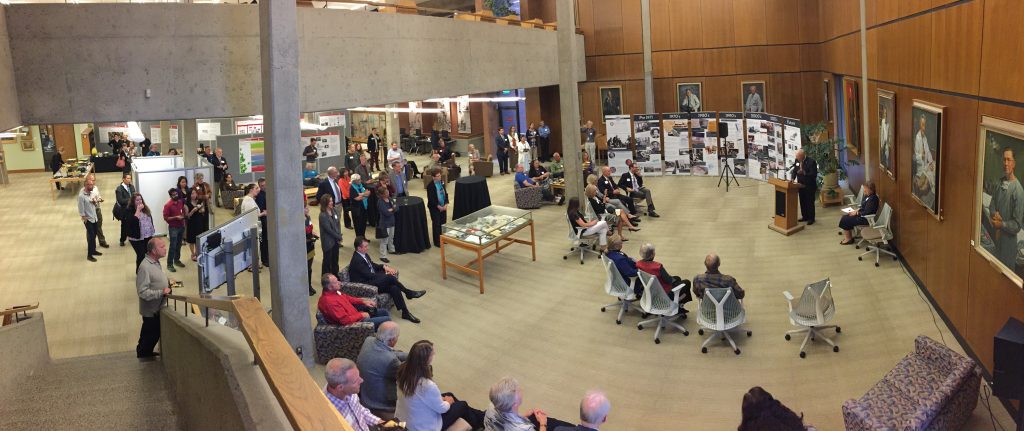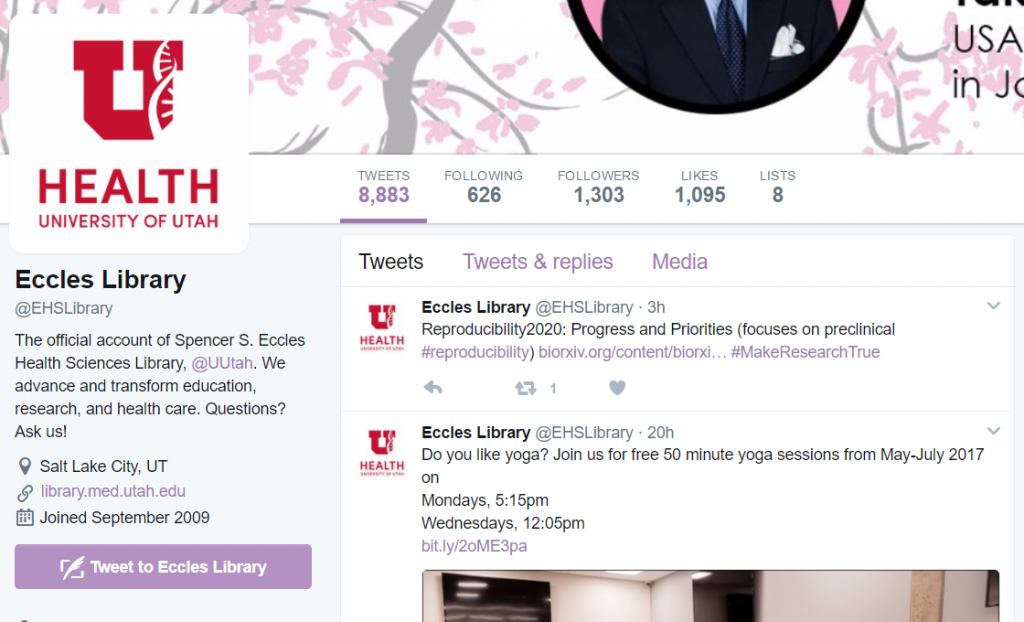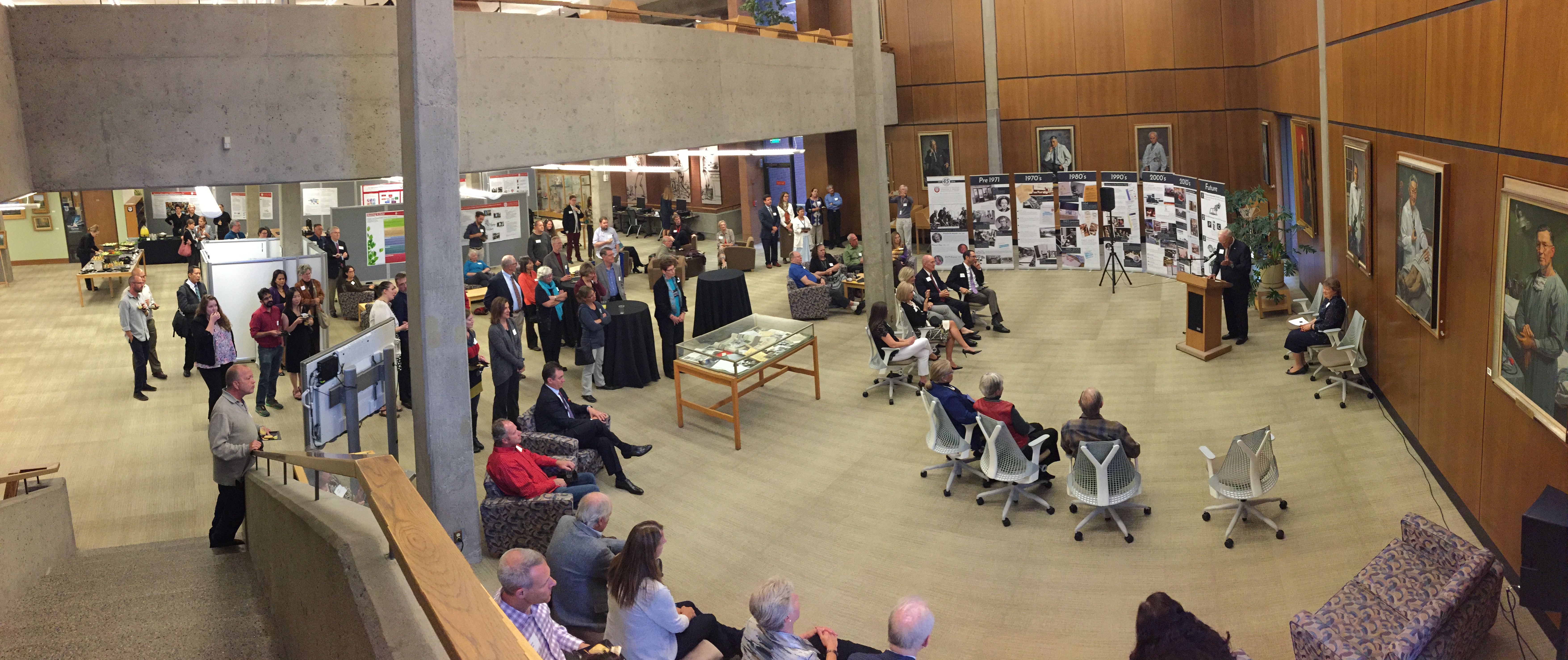In our first Library Spotlight, we speak with librarians from the University of Utah’s Spencer S. Eccles Health Sciences Library about embracing technology, collaboration, and yoga.
For years, the University of Utah’s Eccles Health Sciences Library has been developing innovative ways to support and advance health science research and education. Along the way, they transitioned almost completely to a digital collection, raised awareness of the reproducibility crisis, and grew their Twitter following six-fold!
JoVE caught up with Eccles librarians Melissa Rethlefsen, Mellanye Lackey, and Shirley Zhao to hear how their team is advancing research and education, what they’re planning next, and what librarians can start doing today to better engage and serve their patrons.
How does the Eccles Library respond to new technology in research and publishing?

Melissa: This library has always been known for educational technology. The EHSL was the first medical library in the country to have its own webpage. Our current director, Jean Shipman, always has an eye on innovation and how libraries can incorporate new technologies. We’re always looking for the best tools to help our patrons both for research and for education.
Mellanye: We’re actually hiring a Technology Engagement Librarian to focus solely on technology and engaging with different communities around campus. Technology is really pervasive – it’s everyone’s job, but to have someone who can be a liaison between the library and other groups, to learn about the technologies they’re using and bring them back to us is going to be great for the library and for our users. In other libraries, this kind of position gets combined with Systems Librarians or Web Developer Librarians. But here, it’s just going to be all technology – all the time.
How would you say JoVE content fits with your library’s focus on technology? How are your patrons responding to JoVE?
Mellanye: They’re very happy with JoVE! We perform around 1,500 searches on JoVE every year. I know a few lab directors have shared how much easier it is to have a video showing an experiment being performed, rather than describing it in words.
Shirley: It’s great that a journal like JoVE exists because we need more ways to disseminate different forms of scholarship. Video is a fantastic way to show how a protocol was followed so that someone else can reproduce it.
Melissa: Agreed. We recognize that there are forms of scholarship other than traditional journal articles. That’s why we formed e-channel, a platform for curating and disseminating all types of scholarship, from videos to posters to images. It builds on the success of our previous educational technology projects like NOVEL and, way back, Slice of Life, but with a broader innovation focus. Its primary purpose is to capture the innovative output of our UU Innovation Ecosystem and that of other innovators around the world to provide one place to go to for innovation knowledge.
What results are you seeing from your transition to digital resources?

Melissa: Our patrons seem very happy with it. Biomedicine is such a digital-information culture that we were primarily offering most of our services online anyway. Now 99% of our collection is digital! This has enabled us to make the library much more of a community gathering center. We have events here, yoga, an art gallery, invited speakers, you name it.
Mellanye: Another benefit of being digital is that we can better analyze statistics and track how our collection is actually being used.
Melissa: Definitely! Also, I know that when we started buying backfiles of journals electronically that their usage shot up, something like a 600% increase. Overall, I think our patrons really appreciate it because they’re already at their desks doing work and now can access everything they need. Plus, we’re able to utilize the library space in a different way.
Do you feel that events like yoga and art showings help to break down the barriers between librarians and researchers, faculty, and students?
Mellanye: Absolutely! Our library serves over 1,900 faculty and more than 4,600 students. These events bring together a cross-section of them all and I think partnerships do come from that. I know there are a number of people I’ve met, people I wouldn’t have otherwise, who have gone on to work with me on interesting projects and collaborations.
How are you working to foster more of these collaborations at your institution?

Shirley: We have a collaboration space in the library called Synapse, which houses a Sim Lab that is dedicated to interprofessional education – bringing together groups who would be together in a hospital setting and having them all work side-by-side to understand how all of their roles function together to support patients. Another fruitful collaboration we had was working with our nursing faculty to create a new ebook. The students actually wrote it and we helped facilitate putting it together, publishing it, and disseminating it.
Mellanye: We also offer our Systematic Review Core. As a part of an agreement with our researchers, we offer a service to help them with their review. We get paid for our expertise, the support brings us more on par with other subject matter experts in the health sciences, and we have an expectation that we’ll be named as an author.
Melissa: We’re also involved in a lot of grants. That’s definitely a big thing for us. In biomedicine, I think there’s also a huge shift that’s happening: away from Principal Investigator culture toward “Team Science”. They’re starting to reach out to the other side of campus, and we’re really trying to be there to help them.
Last year you started the #MakeResearchTrue movement. How are you continuing your work to increase research reproducibility?

Shirley: This summer we are going to be offering a short course with the Biomedical Informatics Department on reproducible science. We’re still in the process of planning that, but it came as a result of the reproducibility conference we hosted.
Melissa: In 2018, we’re partnering with several groups on campus to create a credit-based, week-long course. To kick off the week we’ll be hosting our 2nd Research Reproducibility conference. We have high hopes that this course will become a requirement on campus for our postdocs and grad students. We’re really excited about that, but we don’t want to lose momentum. So, throughout this year we’re hoping to host a seminar series on research reproducibility.
How important is social media for raising awareness of all these efforts?

Melissa: Very important! It’s not a perfect means of communication by any stretch of the imagination, but we do get quite a bit of engagement from our local faculty, staff, and students. And, as a medical librarian, I rely on Twitter to stay up to date.That’s where I see a lot of things that I pass over to the Eccles account.
Shirley: I do the same thing. Nowadays, social media is my primary source of information. It’s where I get a lot of the information that I want to share on my personal account and the Eccles account. And it really does help us to engage with our faculty. Reproducibility, in particular, has gotten us a ton of attention from faculty and students.
Melissa: Shirley and I both run the Eccles account along with some others. But when I started, our webmaster was the only person who was using our Twitter account, but he wasn’t a librarian and didn’t have a good way to know what might be helpful to us and to the community. When I came I purposefully opened access to different people so that the content is always new and relevant. I think that’s one of the problems that other libraries have faced. We wanted to have fresh content that people can learn from.
What’s the one thing librarians can do to best support scientific research and education?
Melissa: All the things.
Shirley: I’d encourage librarians to try. Try new services, try new everything. If it doesn’t work, oh well.
Mellanye: That’s true. Continually explore, evolve, and change.
Melissa: I think that’s what medical libraries have always done. That’s why I am a medical librarian. Every single day is different and you have to keep evolving to keep up. That’s what makes this a really challenging role that’s also really fun.


